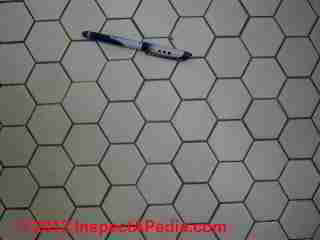 Ceramic, Granite, Marble & Stone & Agglomerate Floor Tile Properties
Ceramic, Granite, Marble & Stone & Agglomerate Floor Tile Properties
- POST a QUESTION or COMMENT about ceramic, granite, marble & stone floor tiles
Non-ceramic floor tile properties: this article discusses and compares the properties of ceramic floor tile, granite tile, marble tile, natural stone and agglomerate floor tiles. We address the installation details for each of these tile types
InspectAPedia tolerates no conflicts of interest. We have no relationship with advertisers, products, or services discussed at this website.
- Daniel Friedman, Publisher/Editor/Author - See WHO ARE WE?
Guide to Ceramic Tile Types: Glazed, Porcelain, Mosaic, Paver, Quarry, Natural Stone, Granite, Agglomerate Floor Tile Properties
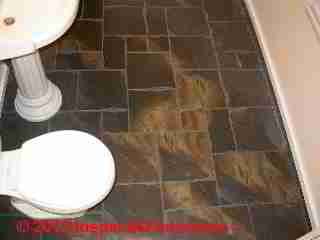 This article series discusses current best design practices for kitchens and bathrooms, including layout, clearances, work space, and accessible kitchen and bathroom layout, clearances, turning space, grab bars, controls, etc.
This article series discusses current best design practices for kitchens and bathrooms, including layout, clearances, work space, and accessible kitchen and bathroom layout, clearances, turning space, grab bars, controls, etc.
We include advice on choosing and installing kitchen countertops, cabinets, and kitchen or bathroom flooring, sinks, and other plumbing fixtures and fixture controls such as faucets. A list of kitchen and bath product manufacturers and sources is included.
[Click to enlarge any image]
This article includes excerpts or adaptations from Best Practices Guide to Residential Construction (Steve Bliss, J Wiley & Sons) , by Steven Bliss, courtesy of Wiley & Sons
Also see flooring basics at FLOOR DESIGNS: KITCHEN & BATH and see CERAMIC TILE FLOOR & WALL.
Our page top photo illustrates an antique hexagonal mosaic type ceramic tile floor installed in the Lotus Club in New York City. Our photo at left illustrates deliberate tile selection patterning in a floor installed by the editor - DF.
A wide variety of man-made synthetic and natural tiles are available (Table 6-6). Most fall into one of the categories described below:
Glazed Ceramic Tile Properties
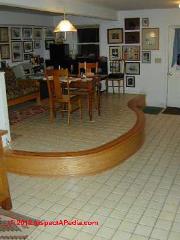 The most common type of tile,
glazed ceramic tile, is usually marketed as either a wall or
floor tile, depending on the hardness and water-absorption
of the underlying clay body of the tile or bisque.
The most common type of tile,
glazed ceramic tile, is usually marketed as either a wall or
floor tile, depending on the hardness and water-absorption
of the underlying clay body of the tile or bisque.
Wall tiles are typically 1/4 inch thick and range in size from 4x4 to 12x12 inches.
Floor tiles are generally thicker and are available in sizes up to 13x13 inches and larger. Some floor tiles may also have a slip-resistant surface, which is advisable in a bathroom. A tile sold for use on floors will not necessarily have a hard scratch-resistant glaze, however.
Where tile scratching is a concern, such as in kitchens and entryways, look for a PEI rating of 3 or higher, or test the scratch resistance of the tile yourself with a cooking utensil or other abrasives the tile might face in service.
The glazed ceramic floor tiles shown at left are a "pillow tile" design in which the edges of each tile slope downwards - a horrible floor to try to mop clean. Installed by the editor. This tile shape is pretty-much discontinued. We're not sorry about that.
Porcelain Tile Characteristics
Porcelain tile is fired at high temperatures, creating a dense and strong material that is impervious to water absorption. The tile has a smooth texture and sharply formed face. Small imperfections in size due to the high firing temperatures give it a less formal look than standard tiles.
Porcelain tile is available unglazed or glazed with a matte or high-gloss finish, and comes in a wide variety of sizes, colors, and shapes. Small 1x1–inch porcelain tiles are commonly used on shower and bathroom floors. These are usually mounted in sheets to simplify installation. Because porcelain is impervious to water absorption and because the mounting sheet can interfere with the bond, it should be installed with a polymer-modified thinset mortar made for use with porcelain.
Mosaic Tile Properties
Mosaic refers not to biblical flooring but rather to any hard, dense tile, such as porcelain, vitreous clay, or glass, that is typically one inch square. Porcelain mosaics are usually unglazed and are colored by adding pigment directly to the clay.
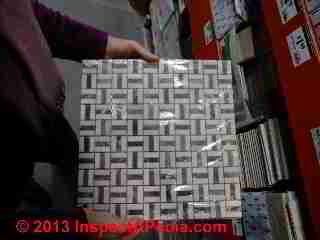
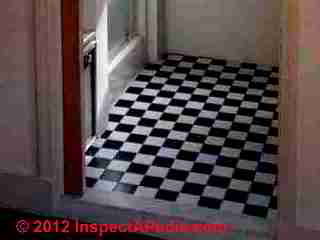
Because it is tough and durable, mosaic tile can work well on just about any application, including floors, shower stalls, and counters. Generally mosaics are mounted in sheets and should be installed with latex-modified thinset mortar (Figure 6-30) and our store photo (above left). The simple checkerboard mosaic tile floor (above right) was installed by the editor.
Paver Tiles Properties
 at left are Mexican clay floor tiles being installed by the crew of David Ramirez in San Miguel de Allende. These tiles are soft and easily broken if not properly bedded in concrete or an equivalent tile setting compound. Here we used concrete.
at left are Mexican clay floor tiles being installed by the crew of David Ramirez in San Miguel de Allende. These tiles are soft and easily broken if not properly bedded in concrete or an equivalent tile setting compound. Here we used concrete.
Handmade pavers, on the other hand, tend to be relatively soft, unglazed, nonvitreous tiles, so they are not suitable for wet interior applications or outdoors in areas subject to freeze/thaw cycles. Handmade pavers are generally made in Mexico from yellow or brown terra cotta and come in various shapes and sizes.
Because they are handmade, they have uneven faces and vary in color and texture from tile to tile, giving a floor a rustic appearance (Figure 6-31).
Handmade paver tiles may come prefinished or require sealing by the installer with either a surface coating or penetrating sealer to provide a wear surface. Penetrating sealers have the advantage of easy refinishing of worn spots, whereas surface coatings need to be stripped before being reapplied.
Machine-made pavers are 1/2 to 3/4 inch thick and are available glazed or unglazed. They are usually made from semivitreous or vitreous clay or impervious porcelain, making them suitable for outdoor use. The glazes used on machine-made paver tiles tend to be very hard and well suited to floors and countertops.
Apply any sealers before grouting. All pavers should be set with a thinset adhesive. Because of their irregular shapes, the individual tiles may need to be “back-buttered” to provide full support and contact with the substrate material.
Quarry Tile Characteristics
Originally made from quarried stone, quarry tiles are typically unglazed, semivitreous or vitreous tiles made from extruded slabs of clay or shale. They are 3/8 to 3/4 inch thick and come in a variety of square and rectangular shapes. They range in color from gray to browns and reds, depending on the type of clay and firing temperature.
These dense, thick tiles have through-color, making them very durable and suitable for heavy traffic as well as wet or exterior applications. The tiles will stain, however, so they should be sealed with surface sealers where that is a concern (the material is too dense for penetrating oil sealers). Since most surface sealers are not suitable for food contact, quarry tile is not a good choice for counters where staining is a concern. Installation should be with thinset adhesive.
Natural Stone Tiles Characteristics
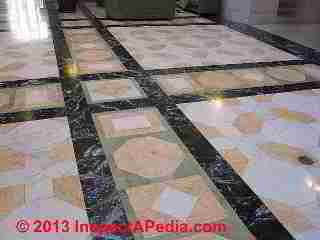 The marble tile floor shown at left is installed in the Vassar College Library, Poughkeepsie, NY.
The marble tile floor shown at left is installed in the Vassar College Library, Poughkeepsie, NY.
Stone and agglomerate stone tiles are popular choices in kitchens and baths due to their durability and natural beauty. Stone tiles typically measure from 3/8 to over 1 inch thick, making some 12-inch square tiles weigh over 10 pounds. The most common stones are marble and granite, since they both can take a high polish.
Of the two, granite is much more durable and stain-resistant, and is unharmed by mild acids that will etch marble and limestone. Granite is stained by oil and grease, however. All natural stones are subject to staining if they are not sealed when installed and resealed whenever water does not bead up on the surface.
Most customers prefer a highly polished finish on natural stone in the kitchen or bath. A polished finish offers some protection against stains but can also make floors slippery and requires maintenance to preserve the sheen.
On kitchen floors, polished stone will eventually lose its sheen in high-traffic areas, unless protective coatings and sealers are applied regularly. Softer and more porous stones, such as limestone and sandstones, are prone to excess wear and staining and are rarely used in kitchens and baths.
On any stone floor, sand, dirt, and grit do the most damage due to their abrasiveness. Commonsense approaches, such as entry mats to clean shoes and frequent dusting with a dry mop, will go a long way toward preserving the stone surface.
Installation Procedures for Stone Tiles
Installation of stone tile is essentially the same as with ceramic tile except for the following:
- Deflection of substrate. Some of the softer stones, such as marble and limestone, require a stiffer floor than the L/360 required for ceramic tile. To meet the stiffer load requirements of L/720 or L/1020, floor joists must be upsized or located closer together. A thicker or double-layer subfloor may also be required.
- Compatibility with setting materials. Porous and light-colored stone tiles may be stained or discolored by certain grouts, adhesives, or sealants. With light colored or translucent stone tiles, it is best to use a white thinset rather than the more common gray type. Also, colored grouts, plumber’s putty, and some caulks will stain lighter-colored stones and porous stones. It is best to test a sample for compatibility before installation.
Marble and Limestone Tile Use & Installation Advice for Kitchens & Baths
Both marble and limestone are carbonates, made from ancient shells, sand, and mud, although marbles have been additionally heated and squeezed until crystallized.
Marbles tend to be denser and less porous than limestones and can take a high polish, but both materials are relatively soft and will etch with mild acids (lemon juice, vinegar), making them unsuitable for kitchen counters unless a rustic appearance is acceptable. Darker stones will etch more noticeably. Limestones and softer marbles are not suitable for floors either.
Marble comes in a wide variety of colors and levels of quality, ranging from Grade A with few to no flaws or voids to Grade D, which has a large proportion of flaws, voids, veins, and lines of separation that need to be repaired with fillers and adhesives during fabrication of the tiles. A fiberglass mesh may also be laminated to the back to provide stability. Some of the most highly prized colored marbles are the least stable.
Tiles are available either polished or honed. Polished marble is suitable for walls or bathroom floors, but the polish will generally not hold up well on kitchen floors or countertops due to wear and tear and mild acid spills.
Although worn marble can be cleaned and re polished, a nonglossy honed finish is a better choice for kitchen floors and counters. The honed finish must be sealed to prevent permanent staining of the porous marble.
Dark green marble, called serpentine, is actually a much harder silicate. It will not etch but has a tendency to warp when wet, so it should not be installed in wet areas or exposed to standing water when cleaned. When installing serpentine, epoxy-based mortars and adhesives are preferable to water- or latex-based products. Pre sealers, applied before grouting, help prevent stains and simplify cleanup, particularly with non polished finishes.
Granite Tile Choices & Installation Advice for Kitchens or Baths
Granite is a hard, granular igneous rock that contains mostly quartz and feldspars and ranges in color from pink and red to light or dark gray or a mix of these. It is generally uniform in color and has high compressive strength and abrasion resistance. It has very low absorption, but some types, especially the popular swirl types (technically called gneiss), are subject to staining if not sealed. Common finishes include polished, honed, or thermal.
Polished granite tiles are suitable for kitchen and bath walls, floors, or countertops. While granite holds its polish longer than marble and is not bothered by mild acids, such as orange juice or vinegar, over time the traffic on a kitchen floor will dull the finish. Use of doormats and frequent sweeping to remove abrasives from the floor will help prolong the finish. Re polishing the granite tends to be expensive due to the hardness of the material.
Waxing and special coatings may help protect the polished finish, but frequent stripping and reapplication can, by itself, cause excessive wear.
Another option for floors are honed or thermal finished granite tiles, which are more commonly used outdoors. These are less slippery when wet than polished granite. However, a sealer is required with this type of finish to prevent staining during grouting and to protect from oil or grease stains. These finishes are easy to apply and do not need stripping for touch-up reapplication.
Agglomerate Tiles for Kitchens or Baths: Recommendations, Installation
Agglomerate tiles consist of graded chips of marble or granite mixed with a resin binder and stone dust. Typical thicknesses vary from about 1/4 inch to 7/8 inch. Agglomerates usually cost less than natural stone, but have many of the same virtues and limitations as their natural counterparts.
For example, granite agglomerates are harder than marble agglomerates, and the polish on granite can withstand greater abrasion and last longer. Also, granite agglomerates will resist mild household acids, such as citrus juice and vinegar, while these will tend to etch marble agglomerates.
Guide to Using Kitchen or Bath Tile Sealers
A wide variety of proprietary sealers are available to protect natural stone against staining from grout, dirt, foods, and household products. In addition, some sealers help conceal minor scratches and increase slip resistance.
Some products require regular reapplication and
may cause a surface buildup unless stripped. Penetrating
oil-type sealers may change the color of some types of
stone and can even trap dirt in the finish. For best results,
follow recommendations of the stone supplier and use
products with an established track record.
Kitchen and Bath Product Manufacturers, Sources, Associations
Ceramic Tile-Setting Material Manufacturer List
Bonsal American www.bonsal.com Setting compounds, grouts, preformed shower pans, curbs, and niches. Also, distributor of backerboards, isolation membranes, and other tile-setting products
Color Caulk, div. of Roanoke Companies Group www.colorcaulk.com Color-matched caulking
Custom Building Products www.custombuildingproducts.com Elastomeric and liquid-applied membranes, self-leveling underlayments, setting compounds, and grouts
Laticrete International www.laticrete.com Trowel-on membranes, self-leveling underlayments, setting compounds, grouts, and sealants
Noble Company www.noblecompany.com CPE sheet membranes, trowel-on membranes, clamping ring drains, and preformed slopes, niches, and curbs
Mapei www.mapei.com Trowel-on and sheet membranes, self-leveling underlayments, setting compounds, grouts, and color-matched sanded caulks
Ceramic Tile Backerboard Producers
Custom Building Products www.custombuildingproducts.com Wonderboard cement backerboard, Easyboard cement and polystyrene lightweight backerboard, and Rhinoboard fiber-cement backerboard
Georgia-Pacific Gypsum www.gp.com/build Denshield gypboard backer with glass-matt facing
James Hardie Building Products www.jameshardie.com Fiber-cement backerboard
National Gypsum www.nationalgypsum.com Permabase lightweight cement and polystyrene backerboard
Schluter Systems www.schluter.com Kerdi tile membrane goes directly over drywall or other substrates
T. Clear Corp./Fin Pan Inc. www.finpan.com Util-A-Crete lightweight concrete backerboard
U.S. Gypsum www.usg.com Durock cement backerboard
W. R. Bonsal www.bonsal.com Extruded polystyrene backerboard with fiberglassreinforced cement facing
Kitchen & Bath Industry Associations
Association of Home Appliance Manufacturers(AHAM) www.aham.org
National Kitchen and Bath Association (NKBA) www.nkba.org
Ceramic Tile Institute of America www.ctioa.org
Home Ventilation Institute (HVI) www.hvi.org
Marble Institute of America www.marble-institute.com Porcelain Enamel Institute (PEI) www.porcelainenamel.com
Tile Council of America (TCA) www.tileusa.com
- - Adapted with permission from Best Practices Guide to Residential Construction (Steve Bliss, J Wiley & Sons) .
...
Continue reading at CERAMIC TILE FLOOR & WALL or select a topic from the closely-related articles below, or see the complete ARTICLE INDEX.
Or see these
Recommended Articles
- BATH & KITCHEN DESIGN GUIDE - home
- CERAMIC TILE DAMAGE REPAIR
- CERAMIC TILE FLOOR INSTALLATION
- FLOOR DAMAGE DIAGNOSIS
- FLOOR DESIGNS: KITCHEN & BATH
- FLOOR FRAMING & SUBFLOOR for TILE
- FLOOR, RESILIENT VINYL or CORK
- FLOOR, STONE, GRANITE, MARBLE, AGGLOMERATE
- FLOOR TILE INSTALL on CONCRETE
- FLOOR TILE SEALERS, CERAMIC, STONE
- TILED WALKING SURFACE SLIP HAZARDS
- FLOOR TILE SETTING COMPOUNDS
- FLOOR TYPES & DEFECTS
- FLOORING MATERIALS, AGE, TYPES
- GROUT INSTALLATION, TILE
Suggested citation for this web page
FLOOR, STONE, GRANITE, MARBLE, AGGLOMERATE at InspectApedia.com - online encyclopedia of building & environmental inspection, testing, diagnosis, repair, & problem prevention advice.
Or see this
INDEX to RELATED ARTICLES: ARTICLE INDEX to BATH & KITCHEN
Or use the SEARCH BOX found below to Ask a Question or Search InspectApedia
Ask a Question or Search InspectApedia
Try the search box just below, or if you prefer, post a question or comment in the Comments box below and we will respond promptly.
Search the InspectApedia website
Note: appearance of your Comment below may be delayed: if your comment contains an image, photograph, web link, or text that looks to the software as if it might be a web link, your posting will appear after it has been approved by a moderator. Apologies for the delay.
Only one image can be added per comment but you can post as many comments, and therefore images, as you like.
You will not receive a notification when a response to your question has been posted.
Please bookmark this page to make it easy for you to check back for our response.
IF above you see "Comment Form is loading comments..." then COMMENT BOX - countable.ca / bawkbox.com IS NOT WORKING.
In any case you are welcome to send an email directly to us at InspectApedia.com at editor@inspectApedia.com
We'll reply to you directly. Please help us help you by noting, in your email, the URL of the InspectApedia page where you wanted to comment.
Citations & References
In addition to any citations in the article above, a full list is available on request.
- Best Practices Guide to Residential Construction, by Steven Bliss. John Wiley & Sons, 2006. ISBN-10: 0471648361, ISBN-13: 978-0471648369, Hardcover: 320 pages, available from Amazon.com and also Wiley.com. See our book review of this publication.
- In addition to citations & references found in this article, see the research citations given at the end of the related articles found at our suggested
CONTINUE READING or RECOMMENDED ARTICLES.
- Carson, Dunlop & Associates Ltd., 120 Carlton Street Suite 407, Toronto ON M5A 4K2. Tel: (416) 964-9415 1-800-268-7070 Email: info@carsondunlop.com. Alan Carson is a past president of ASHI, the American Society of Home Inspectors.
Thanks to Alan Carson and Bob Dunlop, for permission for InspectAPedia to use text excerpts from The HOME REFERENCE BOOK - the Encyclopedia of Homes and to use illustrations from The ILLUSTRATED HOME .
Carson Dunlop Associates provides extensive home inspection education and report writing material. In gratitude we provide links to tsome Carson Dunlop Associates products and services.

